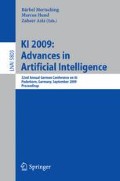Abstract
This paper shows for the first time that a Learning Classifier System, namely XCSF, can learn to control a realistic arm model with four degrees of freedom in a three-dimensional workspace. XCSF learns a locally linear approximation of the Jacobian of the arm kinematics, that is, it learns linear predictions of hand location changes given joint angle changes, where the predictions are conditioned on current joint angles. To control the arm, the linear mappings are inverted—deriving appropriate motor commands given desired hand movement directions. Due to the locally linear model, the inversely desired joint angle changes can be easily derived, while effectively resolving kinematic redundancies on the fly. Adaptive PD controllers are used to finally translate the desired joint angle changes into appropriate motor commands. This paper shows that XCSF scales to three dimensional workspaces. It reliably learns to control a four degree of freedom arm in a three dimensional work space accurately and effectively while flexibly incorporating additional task constraints.
Access this chapter
Tax calculation will be finalised at checkout
Purchases are for personal use only
Preview
Unable to display preview. Download preview PDF.
References
Craig, J.J.: Introduction to Robotics: Mechanics and Control. Addison-Wesley Longman Publishing Co., Inc., Boston (1989)
Baker, D.R., Wampler II., C.W.: On the inverse kinematics of redundant manipulators. The International Journal of Robotics Research 7(2), 3–21 (1988)
Holland, J.H., Reitman, J.S.: Cognitive systems based on adaptive algorithms. SIGART Bull. 63(63), 49 (1977)
Butz, M.V., Herbort, O.: Context-dependent predictions and cognitive arm control with XCSF. In: GECCO 2008: Proceedings of the 10th annual conference on Genetic and evolutionary computation, pp. 1357–1364. ACM, New York (2008)
Butz, M.V., Pedersen, G.K., Stalph, P.O.: Learning sensorimotor control structures with XCSF: Redundancy exploitation and dynamic control. In: GECCO 2009: Proceedings of the 11th annual conference on Genetic and evolutionary computation, pp. 1171–1178 (2009)
Wilson, S.W.: Classifiers that approximate functions. Natural Computing 1, 211–234 (2002)
Wilson, S.W.: Classifier fitness based on accuracy. Evolutionary Computation 3(2), 149–175 (1995)
Butz, M.V., Lanzi, P.L., Wilson, S.W.: Function approximation with XCS: Hyperellipsoidal conditions, recursive least squares, and compaction. IEEE Transactions on Evolutionary Computation 12, 355–376 (2008)
Lanzi, P.L., Loiacono, D., Wilson, S.W., Goldberg, D.E.: Prediction update algorithms for XCSF: RLS, kalman filter, and gain adaptation. In: GECCO 2006: Proceedings of the 8th annual conference on Genetic and evolutionary computation, pp. 1505–1512. ACM, New York (2006)
Salaün, C., Padois, V., Sigaud, O.: Control of redundant robots using learned models: An operational space control approach. In: IEEE/RSJ International Conference on Intelligent Robots and Systems (submitted)
Vijayakumar, S., D’Souza, A., Schaal, S.: Incremental online learning in high dimensions. Neural Computation 17, 2602–2634 (2005)
Vijayakumar, S., Schaal, S.: Locally weighted projection regression: An O(n) algorithm for incremental real time learning in high dimensional space. In: ICML 2000: Proceedings of the Seventeenth International Conference on Machine Learning, pp. 1079–1086. Morgan Kaufmann Publishers Inc., San Francisco (2000)
Orriols-Puig, A., Bernadó-Mansilla, E.: Bounding XCS’s parameters for unbalanced datasets. In: GECCO 2006: Proceedings of the 8th annual conference on Genetic and evolutionary computation, pp. 1561–1568. ACM, New York (2006)
Author information
Authors and Affiliations
Editor information
Editors and Affiliations
Rights and permissions
Copyright information
© 2009 Springer-Verlag Berlin Heidelberg
About this paper
Cite this paper
Stalph, P.O., Butz, M.V., Pedersen, G.K.M. (2009). Controlling a Four Degree of Freedom Arm in 3D Using the XCSF Learning Classifier System. In: Mertsching, B., Hund, M., Aziz, Z. (eds) KI 2009: Advances in Artificial Intelligence. KI 2009. Lecture Notes in Computer Science(), vol 5803. Springer, Berlin, Heidelberg. https://doi.org/10.1007/978-3-642-04617-9_25
Download citation
DOI: https://doi.org/10.1007/978-3-642-04617-9_25
Publisher Name: Springer, Berlin, Heidelberg
Print ISBN: 978-3-642-04616-2
Online ISBN: 978-3-642-04617-9
eBook Packages: Computer ScienceComputer Science (R0)

